
Agios Nikolaos
Agios Nikolaos is a coastal town on the Greek island of Crete, lying east of the island's capital Heraklion, north of the town of Ierapetra and west of the town of Sitia. Agios Nikolaos was settled in the late Bronze Age by Dorian occupants of Lato, at a time when the security of the Lato hillfort became a lesser concern and easy access to the harbour at Agios Nikolaos became more important. The name Agios Nikolaos means Saint Nicholas. Its stress lies on the second syllable of the word "Nikolaos". Agios Nikolaos or Ayios Nikolaos (alternative romanizations of the Greek Άγιος Νικόλαος) is a common placename in Greece and Cyprus, since Saint Nicholas is the patron saint of sailors and of all of Greece. With a beautuful port area, pedestrian streets, blue waters, hidden churches, and a small lake surrounded by a lot of restaurants and rocky cliffs, this is a must-see destination for travelers coming to Crete. Located 65 kilometers east of Heraklion, Agios Nikolaos lies on the slopes above scenic Mirabello Bay, close to Elounda, where you'll find some of Crete's most popular luxury resort hotels. Some of Crete's most spectacular beaches are found within a short drive of Agios Nikolaos. You can do trips to olive farms too, abandoned castles, rural villages, and other nearby attractions.

Lake Voulismeni
Lake Voulismeni is a former sweetwater small lake, later connected to the sea, located at the centre of the town of Agios Nikolaos on the Greek island of Crete. It has a circular shape of a diameter of 137 m and depth 48.8m. The locals refer to it as simply "the lake". The lake is connected to the harbour of the town by a channel dug by the French army in 1907. A panoramic view of the lake can be seen from a small park situated above it. According to legend, the goddess Athena bathed in it. Every year at midnight turning to Orthodox Christian Easter day, the majority of the population of the town gathers around the lake to celebrate with fireworks, and firecrackers thrown by the people attending that highlight event. The rocks at the lake are limestone breccias, the result of undersea landslides coming down from the mountains to the north-west of the town. As you stroll around the shoreline a variety of open-air restaurants line the lake, and others are perched atop the dramatic rock face overlooking the water. From up high, you can see beyond the lake to the sea behind.

The Port Area
The port of Agios Nikolaos is located at the very heart of the city and Its located just 50 minutes from Heraklion International Airport. Just across the small bridge from Lake Voulismeni is the port area of Agios Nikolaos. It is surrounded by waterfront cafeterias, shops with souvenirs and local products and various hotels and apartments. The port is actually a harbour (about 200m in length) near the larger ports of Greece and Turkey and a favourite destination for cruise liners in the south-eastern Mediterranean available for docking throughout the year. Most commercial boat tours leave from here, including a famous tourist destination to Spinalonga Island, is just an hour away by boat.
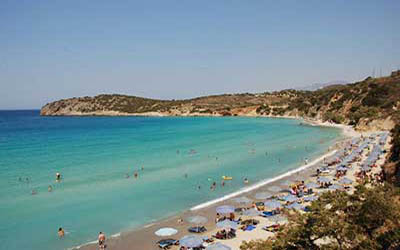
Voulisma Beach
Voulisma is the second of the three bays of Istron village. Istron village is close to Kalo Chorio and is about 12 km east of Agios Nikolaos and 22 km north of Ierapetra. Approximately 500 meters east of Kalo Chorio is located Voulisma beach or Golden Beach. Its length is about 700 meters and is the largest beach of Kalo Chorio. Located just a 10-minute drive down the coast from Agios Nikolaos, Voulisma beach has white clean sand and deep turquoise waters that gets warm in the hot Cretan sun. It's also perfect for children because the sea is quite shallow and the water is pleasantly warm. It is organized, but it’s characterized by mild interference. The whole area near Voulisma Beach is accordingly considered as tourist resort with a lot of hotels and apartments. A long set of stairs leads down from the carpark, and a few beach shops have umbrellas and chairs for rent and sell refreshments and snacks.
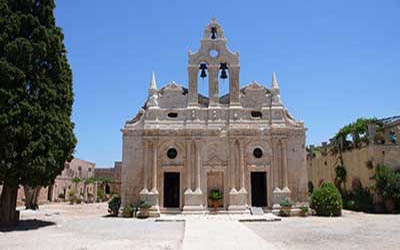
Arkadi Monastery
The Orthodox Church played an important role in liberating Greece from Turkish occupation. Set amid the rural foothills of Psiloritis (Mount Idi), 23 kilometers southeast of Rethymnon, this fortress-like 16th-century monastery is surrounded by high stone walls. Today, it's a wonderfully peaceful place, with a delightful Baroque church and a rose garden, but it has not always been so.In 1866, the monastery became the central meeting place for Cretan revolutionaries, with the Abbot as chairman. During an uprising against the Turks, some 900 locals (mainly women and children), who had taken refuge here, chose to blow themselves up rather than surrender. Outside the monastery, their skulls are displayed in glass cabinets as a haunting monument to their bravery.
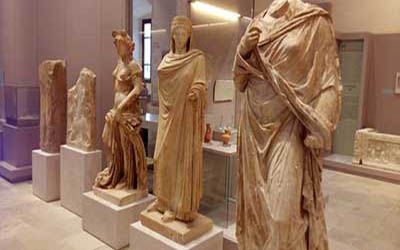
Archaeological Museum of Rethymnon
This small museum holds a variety of historical treasures from the city and surrounding area. Well worth a quick stop, you'll see items from Neolithic, Roman, and Minoan times. Also on display is a collection of jewelry and coins, along with Roman statues.The admission fee is very modest, and display panels have descriptions in multiple languages.
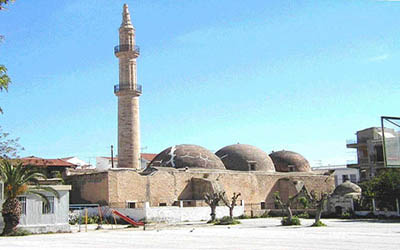
Neratze Mosque
Found near the center of town and easily recognized by its 27-meter-high minaret, is the Neratze Mosque, dating from 1600. No longer functioning as a religious building, it now hosts musical concerts. It is not open for tours, but be sure to have a look at the main doorway as you walk by. Out front is a large courtyard, and around the side you'll find pleasant cafés in the shadow of the walls.
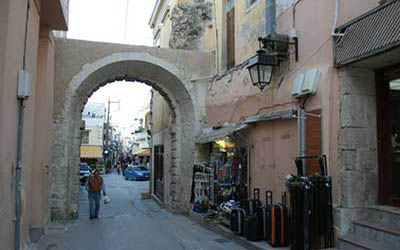
Porta Guora
Located at the south end of the old town, this is the only remaining structure from the 16th-century walls. Arching over the narrow street below, this landmark is an ideal place to start your visit to the old town.If you continue straight down this main road, you'll pass by some of the highlights of the old town, including the Rimondi Fountain. Porta Guora also goes by the name of Great Gate of Reythmnon.
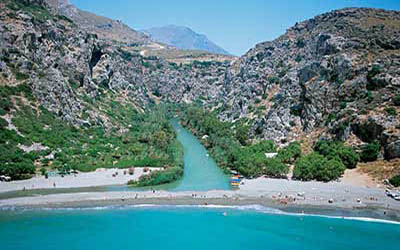
Preveli Palmbeach
Some of Crete's most beautiful beaches are on the remote south coast looking out on the Libyan Sea. Hidden away below Preveli Monastery, which is 36 kilometers south of Rethymnon, this fine pebble beach lies at the mouth of a river and is backed by a lush palm grove. Visiting this beach is one of the top things to do in the area. You have to walk down to the beach from the parking area high above, which takes about 15 to 20 minutes. If you don't feel like expending the energy to hike down, there are beautiful views over the beach from the area just beyond the back of the parking lot.
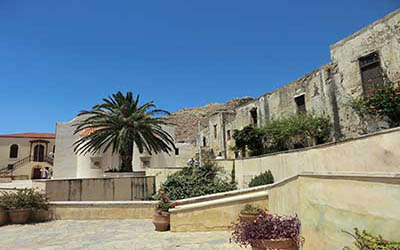
Preveli Monastery
On Crete's isolated south coast, built into a remote hillside overlooking the Libyan Sea, Preveli Monastery lies 36 kilometers south of Rethymnon and is only accessible via a winding road through the mountains. Dating from the 17th-century, the monastery features a church and a small museum displaying icons and ecclesiastical paraphernalia.Outside stands a Memorial for Peace and Resistance, erected in 2002. During the Battle of Crete, in 1941, the monks at Preveli gave supplies and shelter to the Allies. The monument is composed of a large headstone, with an unusual statue of a priest (holding a machine gun) and a soldier (one of the Allies) standing to each side. From here, you have absolutely stunning views down onto the sea.The drive to the monestary offers beautiful views over the south coast. You can combine a trip here with a stop at nearby Preveli Beach.
Official site:http://www.preveli.org/files/moni/enindex.htm


